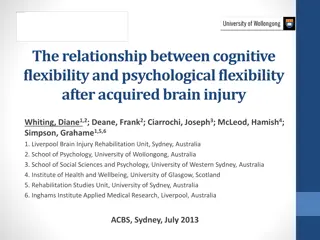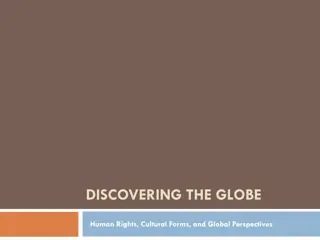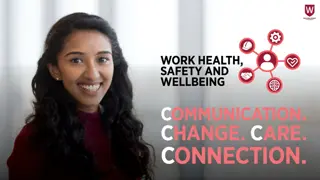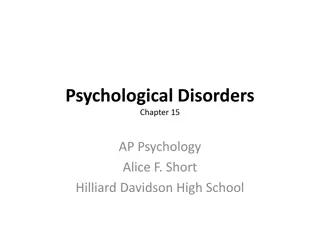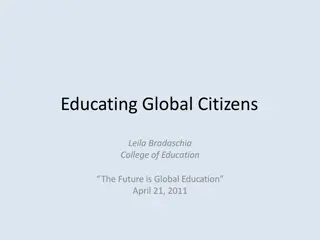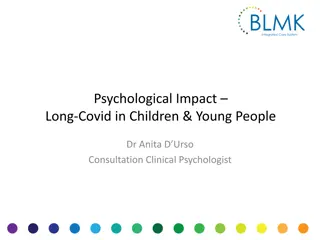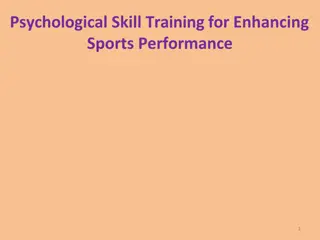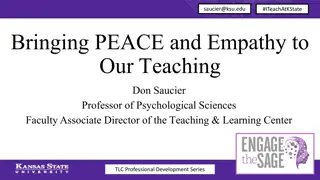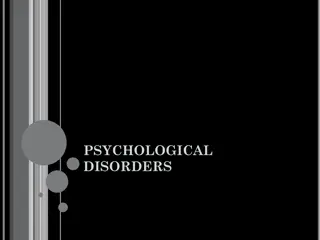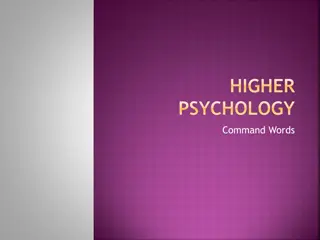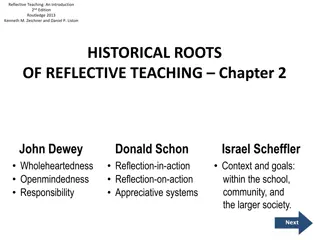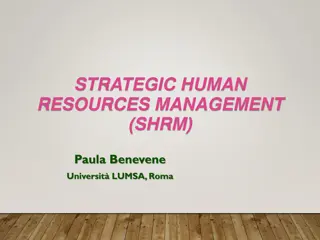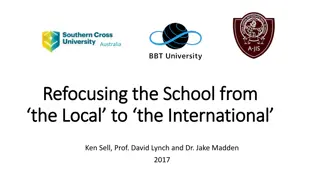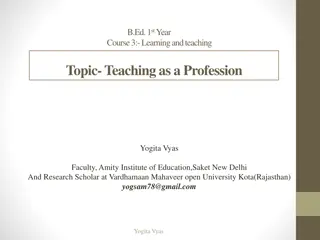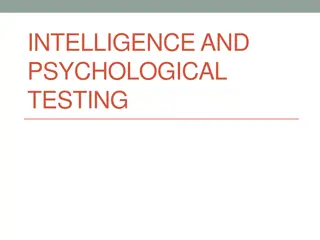Understanding Psychological Challenges in Teaching Global Perspectives
Exploring the impact of psychological biases like actor-observer bias, confirmation bias, and cognitive dissonance on teaching global perspectives. Insights from James Dawes shed light on how our perceptions and judgments are influenced by internal biases, affecting our ability to embrace diversity and global citizenship.
Uploaded on Sep 17, 2024 | 0 Views
Download Presentation

Please find below an Image/Link to download the presentation.
The content on the website is provided AS IS for your information and personal use only. It may not be sold, licensed, or shared on other websites without obtaining consent from the author. Download presentation by click this link. If you encounter any issues during the download, it is possible that the publisher has removed the file from their server.
E N D
Presentation Transcript
DISCOVERING THE GLOBE Using Inquiry Guided Learning to Teach Global Topics
Todays topics Why Teach Global Perspectives Pedagogical Challenges Psychological Cultural and Social Inquiry Guided Learning and Global Perspectives Problem-Based Learning and Case Studies
Why teach global perspectives? Global Economy Movement of People Climate Change and Sustainability Increasing Challenges of Developing Nations International Conflicts and National Security Technology and a Networked Globe Global Citizenship
James Dawes We see our own negative actions as a result of our situation and see the negative actions of others as a result of their nature (actor-observer bias); we like familiar things just because they are familiar (mere-exposure effect); we perceive diversity in our own communities but think of members of other communities as "all the same" (outgroup homogeneity bias). On top of that, we pay more attention to negative information than positive information, focusing on threats over signs of safety, remembering bad experiences more intensely than good ones, giving more weight to negative information about strangers than positive information, experiencing our dislike of bad behavior in others more intensely than our liking of their good behavior, and forming negative stereotypes about others more quickly and with less data than we do when forming positive stereotypes (negativity bias).
Dawes continued This gets worse when we are anxious or insecure. We are even more likely, then, to stereotype others, show in-group favoritism, judge members of our group as possessing better features than those of other groups, engage in downward social comparison (focusing on worse-off others to comfort ourselves) and, subsequently, to remember negative rather than positive things about those handy worse-off others. Finally, we seek out information that confirms our existing beliefs, while filtering out information that challenges them (confirmation bias); and we seek cognitive consistency at sometimes unbearable costs, denying even the plainest revealed truths if accepting them would require us to give up, with pain, previously cherished beliefs (cognitive dissonance).
Psychological Challenges actor-observer bias mere-exposure effect outgroup homogeneity bias negativity bias focusing on worse-off others to comfort ourselves confirmation bias cognitive dissonance just-world phenomenon
Actor-Observer Bias refers to a tendency to attribute one's own action to external causes, while attributing other people's behaviors to internal causes. The actor-observer bias tends to be more pronounced in situations where the outcomes are negative. Essentially, people tend to make different attributions depending upon whether they are the actor or the observer in a situation (Jones & Nisbett, 1971). Source: http://psychology.about.com/od/aindex/g/actor-observer.htm
Mere-exposure Effect People feel a preference for people or things simply because they are familiar. Has no basis in logic. Makes foreign cultures uncomfortable and new behaviors seems strange.
Outgroup Homogeneity Bias One s perception of out-group members as more similar to one another than are in-group members. Thus "they are alike; we are diverse". People have a more differentiated cognitive representation of in-groups than of out-groups. Makes it hard for us to see out-groups as complex. The out-group homogeneity bias relates to social identity theory, which states that humans categorize people, themselves included; identify with in- groups; and compare their own groups with other groups (out-groups). Identification with in-groups promotes self-esteem; by comparing ourselves with out-groups, we gain a favorable bias toward our in-group, known as in-group bias. Source: http://en.wikipedia.org/wiki/Out-group_homogeneity_bias
Negativity Bias A psychological phenomenon by which humans pay more attention to and give more weight to negative rather than positive experiences or other kinds of information. Impact on Global Perspectives: When given a piece of positive information and a piece of negative information about a stranger, people's judgment of the stranger will be negative, rather than neutral.
Focus on Worse off others System justification theory proposes people have a motivation to defend and bolster the status quo, that is, to see it as good, legitimate, and desirable. People not only want to hold favorable attitudes about themselves (ego-justification) and their own groups (group-justification), but they also want to hold favorable attitudes about the overarching social order (system-justification). A consequence of this tendency is that existing social, economic, and political arrangements tend to be preferred, and alternatives to the status quo are disparaged. Source: http://en.wikipedia.org/wiki/System_justification
Confirmation Bias A tendency for people to favor information that confirms their preconceptions or hypotheses regardless of whether the information is true. As a result, people gather evidence and recall information from memory selectively, and interpret it in a biased way. The biases appear in particular for emotionally significant issues and for established beliefs. Contributes to overconfidence in personal beliefs and can maintain or strengthen beliefs in the face of contrary evidence. Hence they can lead to disastrous decisions, especially in organizational, military, political and social contexts. Source: http://en.wikipedia.org/wiki/Confirmation_bias
Cognitive Dissonance The uncomfortable feeling caused by holding conflicting ideas simultaneously. Thus people have a motivational drive to reduce dissonance. They do this by changing their attitudes, beliefs, and actions. Dissonance is also reduced by justifying, blaming, and denying. This bias makes it hard to undo prejudice since that would require a change in existing beliefs about a group.
Just-world phenomenon The tendency for people to believe that the world is just and therefore people "get what they deserve. Makes it difficult to teach students to have compassion for those from other parts of the world that lead more difficult lives.
Cultural and Social Challenges American Exceptionalism Orientalism Culturalism Racism Power of Prejudice Limited Empathy for Others
American Exceptionalism Refers to the theory that the United States is qualitatively different from other nations. Connected to the idea that it is also better more democratic, more free, more just. Leads to comparisons that tend to create a bias to see the US as better than other nations. How does this connect to national pride?
Orientalism Edward Said Orientalism 1978 A comparison across cultures where the west is ALWAYS seen as superior For example, what are common images of people from the east and from Afghanistan in particular? Exotic Barbaric Uncivilized Less ethical Religious Fanatics What else?
Culturalism Mahmood Mamdani: The tendency to see the problems of other cultures as an endemic cultural trait rather than a political problem. These people are incapable of just rule. They are a bunch of barbarians. Problems around the globe are presented ahistorically and without attention to geopoltics.
Racism There are lots of ways in which subtle racism persists in various ways in our society. Teaching about different cultures can often lead to the presentation of other cultures as static. Cultural explanations for differences can lead to student perceptions that inequalities are the result of cultural difference and not a structural part of society. But being colorblind erases the lived experiences of different groups and ignores diversity.
Everyday Antiracism The ethnographic question to ask about antiracism in education is thus not abstractly whether people should be treated or not treated as race group members in schools (this is the typical US debate about race consciousness vs color blindness ), but rather concretely when and how it helps in real life in specific places to treat people as race group members, and when and how it harms. Static advice to be colorblind regarding one s students, or to celebrate their diversity, or to recognize their identities, is not equally helpful in all situations. In daily life, sometimes being colorblind is quite harmful to young people; sometimes a celebration of diversity can be reductive and harmful; sometimes recognizing one aspect of an identity (a student s or one s own) detracts from a sense of common humanity. Today, racism still involves unequally measuring human worth, intelligence and potential along static racial lines, and accepting the distribution of racially unequal opportunities, and the production of racially patterned disparities, as if these are normal. Everyday antiracism in education thus requires that educators make strategic, self-conscious everyday moves to counter these ingrained tendencies. Source- Pollock: http://www.understandingrace.org/resources/pdf/rethinking/pollock.pdf
The Power of Prejudice Prejudice occurs when an individual's stereotypes become rigid and inflexible. The prejudiced individual maintains his/her stereotype about another person or group even when confronted with evidence to the contrary. Source: http://www.unm.edu/~jka/courses/archive/power.html
Challenges to Empathy Empathy is not natural. It takes hard work. Sam Richards takes an Inquiry Guided approach to teaching empathy: http://www.youtube.com/watch?v=kUEGHdQO7WA
Global Connections or Global Contrasts? Teaching global cultures runs risks. Not teaching global cultures runs risks. How can we best face these challenges?
From Challenge to Opportunity These challenges are real but they are not insurmountable. Being mindful of the difficulties we have imagining the lives of others allows us to teach the globe in a way that can have a greater chance of developing global citizenship. Find an approach that balances between celebration and skepticism.
Inquiry Guided Learning IGL is a teaching method that helps overcome some of these challenges Based on asking questions Active curiosity works against biases Can help develop empathy Can show that answers are not easy
Key Features of IGL Is question driven, rather than topic or thesis driven Begins with a general theme to act as a starting point or trigger for learning Emphasizes asking good researchable questions on the theme, and coaches students in doing this Builds library, interview, and web search skills, along with the critical thinking skills necessary for thoughtful review of the information. Coaches students on how to best report their learning in oral or written form. Provides some mechanism (interviews, drafts, minutes of group meetings, bench mark activities, etc.) to help students monitor their progress within the course. Draws on the expertise and knowledge of the instructor to model effective inquiry and to promote reflection.
IGL and Global Perspectives Questiondriven nature helps addressproblemsof stereotypes Challengesof this processhelp students understand the complexitiesof global issues Teachesgood research skills. Students learn to seek sources of information --A practice that can help students ask questionsabout media representations.
Problem Based Learning Problem Based Learning is form of IGL that is structured through a problem. In a problem-based learning (PBL) model, students engage complex, challenging problems and collaboratively work toward their resolution. PBL is about students connecting disciplinary knowledge to real-world problems the motivation to solve a problem becomes the motivation to learn. In PBL, students work together in small groups to solve real-world problems. PBL is an active process that engages students to identify what they know, and more importantly, what they don't know. Their motivation to solve a problem becomes their motivation to find and apply knowledge. Source: http://www.udel.edu/inst/why-pbl.html
PBL and Case Studies Ask students to put themselves in the place of others not solve problems FOR others. They have to see and solve the problem imagining that it is theirs. Create a compelling and interesting problem for students to solve Make sure that it does not have an easy resolution Think about the sorts of information they will need to address it Address any biases that might result from the process and confront these openly Be prepared to discuss the ethics of the problem
PBL and Global Perspectives Asking students to put themselves in the shoes of others encourages empathy. Teaches the difficulty in solving problems helps counter-balance Just-world phenomenon and Self-justification theory. Problems with bias are openly addressed in ways that promote everyday antiracism.
Three samples case studies A culture-based case study for younger students An environmental/sustainability case for middle school A military conflict case for high schoolers



